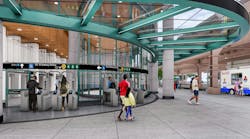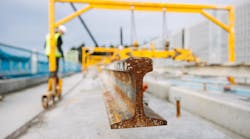Here are some issues that contribute to the New York Metropolitan Transportation Authority's (MTA) multi-billion dollar financial shortfall, $48 billion long-term debt and expensive system expansion projects, including the MTA Long Island Rail Road (LIRR) $11.6 billion East Side Access to Grand Central Madison, $4.5 billion MTA New York City (NYC) Transit Second Avenue Subway Phase 1, along with the future $7.7 billion Second Avenue Subway Phase 2 and proposed $7 billion Second Avenue Subway Phase 2 cross West 125th Street extension and $5.5 billion NYC Transit Brooklyn to Queens Light Rail Street Car Connector projects.
Project cost containment, along with fast tracking procurements and contract change orders for the MTA is sometimes easier said than done due to other significant obstacles.
MTA union work rules sometimes prevent contracting out work to the private sector. Third party private contractors require MTA's NYC Transit, LIRR and Metro-North Railroad agency Force Account (their own employees) to provide both supervision and protection when they work on or adjacent to active right of way track. Sometimes, there are excessive numbers of MTA supervisory or employees assigned, adding to costs.
The MTA, New York State Department of Transportation, New York Thruway Authority, along with Bridge and Tunnel Authority, receive billions each year from the Federal Transit or Federal Highway Administrations. "Buy America" requirements for both transit, bridge and highway projects are one of many requirements for receipt of federal funding. This impacts the MTA's ability get the best bang for the buck, when spending $1.8 billion in direct annual federal formula grant funds and billions more in competitive discretionary, New Starts and Hurricane Sandy relief and resiliency dollars under the MTA $32 billion 2015 - 2019 and $51 billion 2020 - 2024 Five Year Capital Programs. The MTA has its own "Arts in Transit" one percent expenditure requirement. New York Gov. Kathy Hochul has "New York Buy America Act," as well.
Federal Transit Administration (FTA) "Buy America" requirements continue to play a role in the ability of the MTA to both speed up capital projects and contain cost growth. Second is the Davis Bacon requirement of paying prevailing wages. Third is U.S. Cargo preference requirement for private companies to use only American vessels when shipping product from abroad. Finally, prime contractors sometimes have problems finding qualified Disadvantaged Business Enterprise (DBE) sub contractors with specialized skills to meet required federal and state civil rights goals.
Is the FTA in a position to waive any of these requirements for transit projects? Anyone in the transit industry knows that compliance with federal Buy America rules and regulations frequently adds both time and cost to a project. The $11.6 billion East Side Access to Grand Central Madison, $4.5 billion Second Avenue Subway Phase One, along with upcoming $7.7 billion Second Avenue Subway Phase 2 and future $5.5 billion Brooklyn to Queens Light Rail Connector, are good examples of how federal requirements add to costs. You can count on one hand the number of Buy America waivers issued by FTA to transit agencies in recent years.
All four projects have been or are dependent upon securing FTA Capital Investment Grant (CIG) New Starts Core Capacity program funding. This is a national discretionary competitive program. It supplements the various annual FTA formula grant programs. MTA received about $1.8 billion in federal fiscal year 2023 funding under these FTA formula grant programs.
How common is the past LIRR $11.6 billion East Side Access to Grand Central Madison incident of excessive phantom employees on the project payroll? The MTA seldom likes to acknowledge examples of project waste, fraud and abuse. A simple audit was performed 13 years ago by an accountant who reviewed a budget for train platforms being constructed under Grand Central Terminal.
The accountant found funding was provided under the project budget to pay for 900 workers but could only find paper work to justify 700 workers. No one on the project could explain what tasks the other unaccounted for 200 workers performed. These 200 potential phantom employees were being paid $1,000 per day. They were subsequently removed from the payroll. No one ever determined how long they were on the payroll or how much they were paid. There is no evidence that these lost dollars were ever recovered.
The MTA has consistently failed to include more flexible work assignments in union contracts. The option to contract work to the private sector when feasible or hiring part time employees must be more readily available as appropriate without sacrificing the safety and system reliability that riders count on. MTA employees need to increase contributions toward medical insurance and retirement pensions as other government, private sector employees, taxpayers and commuters do. Real reform for MTA employee pensions would be calculated based on the final year's base salary and not inflated by overtime.
Unions who benefit by some of these rules and regulations make campaign contributions, endorsements, mailings, man phone banks and provide volunteers for "get out the vote" operations to candidates running for public office. Elected officials will seldom if ever take the side of commuters and taxpayers versus unions when it comes to supporting any reforms to the capital program.
Notice at every ground breaking ceremony for capital projects, that politicians always have a large contingent of union employees present? Elected officials always promise they are delivering good union paying jobs. They never talk about reforms to work rules that might save the MTA money and time. Commuters, taxpayers and transit advocates deserve better than the current status quo.

Larry Penner
Larry Penner is a transportation advocate, historian and writer who previously served as a former director for the Federal Transit Administration Region 2 New York Office of Operations and Program Management. This included the development, review, approval and oversight for billions in capital projects and programs for New Jersey Transit, New York Metropolitan Transportation Authority, NYC Transit bus, subway and Staten Island Railway, Long Island and Metro North railroads, MTA Bus, NYCDOT Staten Island Ferry along with 30 other transit agencies in New York and New Jersey.







